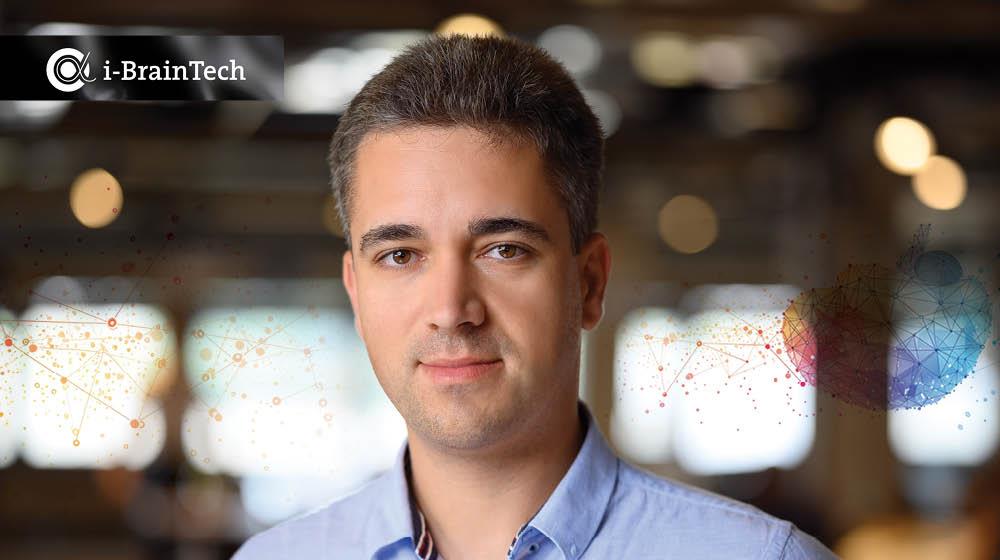Footballing legend Johan Cruyff once said that the beautiful game is played with the brain. i-BrainTech is giving Cruyff’s philosophy a new dimension by blending neuroscience and AI to dramatically improve the cognitive abilities of players.
Here, the company’s founder and CEO, Konstantin Sonkin, discusses the importance of placing cognitive excellence at the forefront of all future endeavours – for both sports and humanity.
“What neuroscience can tell us about the brain, particularly an athlete’s brain,” Konstantin Sonkin muses, “has started to become even more important as we near the physical limits of the body.” Indeed, the relatively steady records at the Olympic Games over the past few decades indicate that sports science is nearing the limits of the human body. “And we see that also in football and sports in general,” he adds, “which is why cognitive excellence is playing a more and more important role.”
Sonkin is the founder and CEO of i-BrainTech, which, though headquartered in neighbouring Israel, shifted part of its operations to Cyprus in 2023. Sonkin was persuaded to make the move after witnessing Cyprus’ vigorous efforts to reinvent itself as what he describes as “a gateway of minds,” a nod to the island’s burgeoning tech and innovation landscape. Armed with a PhD in computational neuroscience, Sonkin has led research at the Centre for Innovation in Neuroscience at Tel Aviv University. Over a decade ago, he foresaw the transformative potential at the intersection of artificial intelligence and brain signals and, during our conversation, he boldly describes this convergence as “the ultimate future and objective of all technological evolution.” Yet, he goes on, while AI has already revolutionised countless fields, the cognitive world – the key to happiness, skills and fulfilment – remains largely unexplored. “This is an inevitability we must address,” he stresses.
Sonkin isn’t just a researcher; he’s also a seasoned businessman with C-level experience in industrial companies. In 2019, he married these two facets of his personality together to give birth to i-BrainTech, which has pioneered a neurofeedback technology, infused with artificial intelligence, to dramatically improve athletes’ decision-making on the field, marking a significant leap forward in the evolution of the sports – or so he adamantly claims.
But what exactly is cognitive excellence?
According to Sonkin, before we can grasp this concept, we must first define what it means to have an excellent athletic brain. Unlike physical sports science, where we can measure myriad components with precision, our understanding of brain skills and performance remains woefully inadequate. “What does neuroscience say about football?” Sonkin asks. “Considering how early we are on this journey, we need professional data to create a foundation for all future studies and applications.” To achieve this, he says, we need meticulous, hype-free research and we should be particularly wary of being associated with companies that promise the moon, offering gimmicky gadgets like GPS trackers while making grandiose neuroscientific claims. “It’s our professional duty to know what is possible and what is absolutely not reachable in the next couple of years. We have to be ethical as scientists and as entrepreneurs,” he asserts.
For any technology aimed at influencing the brain, specificity is crucial; Sonkin maintains that the goal should never be to enhance general intelligence, as it does not necessarily translate into improved field performance. He brings up a fascinating example: he is the same height and age as Lionel Messi, arguably the greatest footballer ever, yet one is a neuroscientist and the other a football star. “What makes him such?” he wonders. “Understanding this is key: different areas of the brain are responsible for different actions, so we must always be specific and develop what matters for the individual.” A crucial point of clarification is that i-BrainTech’s focus is not on improving decision-making per se, but rather on enhancing the prerequisites for decision-making, such as working memory, pattern recognition and attention. Sonkin even argues that there is no singular cognitive phenomenon called decision-making; rather, it is a complex, multifaceted process.
The innovation that i-BrainTech brings to the market is nothing short of groundbreaking: decoding the brain in real time. A player dons a brain sensor cap and sits before a screen displaying an avatar. From there, he selects specific drills – whether it’s perfecting long shots or mastering an offensive manoeuvre that the coach wants to deploy in the next match. This is a game that is played with their mind! Sonkin refers to this as “homework” for players, making them become better individuals contributing to the team. “If you can provide instant, immediate feedback to the efforts of the brain, where a person can actually take the brain activity under control and transform it toward a training environment, that’s a different ball game,” he says, making no excuse for the pun. While these are actions that can be practiced on the pitch, he continues, there is a limit to how much physical strain the body can endure before risking injury. “More than two hours of training is complicated in modern sports,” he explains. “So, you can add what we call additional stimulus for your brain rewiring off the field, provided that you’re fully immersed in what you’re doing.” For the technology to be effective, then, the player must concentrate fully on the task at hand. To simulate the precise path of a ball from a corner kick, he needs to focus intensely on that specific area of the pitch; the same goes for hitting the ball with varying force. “You need to visualise that action in all its detail. By doing so, you activate your motor system at a very high level,” Sonkin notes. Indeed, it doesn’t just prepare players for the next match – it rewires their brains for sustained excellence.
Visualisation in sports is hardly a novel concept. Cristiano Ronaldo, one of the greatest goal scorers in history, has extolled its virtues, crediting it with sharpening his skills and boosting his performance. However, not all players find it easy to imagine themselves in excruciating detail executing specific actions on the field. “Many feel lost and awkward,” Sonkin says, referencing numerous conversations he has had with players. “Did they visualise well enough? Was it actually helping them? So, how many more players could benefit from it if they knew how to quantify their effort?” Mapping such cognitive functions could revolutionise talent identification, opening career avenues for players who might otherwise hit a mental plateau. “How many excellent footballers never had the chance to shine because their maturation levels or speed weren’t fast enough to outpace their more developed counterparts?” he contemplates. “But beyond this, taking into account cognitive development could profoundly alter how we develop ourselves and our children.” Sonkin’s mission is ambitious: he wants sports to be the leading industry for validating new technologies related to human performance as they represent the pinnacle of competition in a scientific context. And by proving that their value in the sports arena is truly transformative, it will be the tipping point, he argues, to fundamentally change how we develop human cognitive skills.
So, how effective is i-BrainTech?
According to Sonkin, the efficacy of the technology has been substantiated through multiple studies focused on two primary areas: skill acquisition and post-injury return to performance. In skill acquisition, studies involving youth teams aged 15-19 from professional clubs have demonstrated remarkable results. Players using the technology saw up to a 30% improvement in specific actions on the field, while the control group showed no significant progress. “These studies were instrumental in illustrating the direct link between cognitive training and enhanced performance on the field,” he remarks. The second focus area – return to performance after injury – revealed another dimension of the technology’s potential. Despite an 81%-85% probability of returning to sports after an ACL injury, only about 60% of athletes regain their pre-injury performance levels. Sonkin explains that this discrepancy is due to neuromuscular inhibition – a mental barrier that prevents the brain from fully reactivating the injured limb even after physical recovery. “After injury and surgery, the brain shuts down activity in the injured limb. You can’t utilise your leg with the same range of motion because the brain creates a barrier. This barrier can be confronted and overcome using a data-driven neuroscientific approach,” he asserts. This technology isn’t just for injuries; it also supports athletes during other physical interruptions, such as pregnancy. Professional female athletes, whose careers are often paused for several months, can continue training without physical exertion. “It allows players to continue feeling a part of the team. This is crucial and represents a significant transformation in how players return to performance after an absence,” Sonkin notes, adding that the versatility of i-BrainTech’s core technology means it can be tailored to various sports, considering specific needs and values. The platform has already proven effective for basketball players and has recently been adapted for volleyball.
By essentially creating a new market – though he eschews the term “disruptive,” preferring to view the company’s work as adding a new chapter to the book of sports science – Konstantin Sonkin has faced his fair share of scepticism. He welcomes it. Football is big business with massive stakes, so scepticism acts as a filter that cuts through the hype. “In the last three years, we’ve been building an understanding of the market and gaining acceptance from opinion leaders. Now, we are already in top leagues in 10 countries worldwide, including in Europe,” he notes. i-BrainTech’s clientele includes big -name clubs such as Juventus, Benfica and Real Sociedad, along with organisations like the Israel Football Players’ Organization (IFPO) and several sports medicine clinics. Another testament to the technology’s impact is the fact that the company has raised $7.5 million across two funding rounds – the first led by US pre-seed investor Techstars and the second by customers who became investors. “We have 50 people in our i-Brain network, including R&D, operations and business development, distributed globally across the UK, the US, Europe and India. After several years of crucial R&D and validation, we are now experiencing organic growth,” Sonkin adds.
While we’re talking about brains, I want to ask about the future of this technology, not only in sports but in the world at large. Sonkin takes a moment to collect his thoughts before offering a thought-provoking perspective: against the backdrop of escalating global tensions and the disruptive force of artificial intelligence, our survival hinges on developing cognitive excellence. “AI will be smarter than us in a year or two. If we don’t focus on our own development, we’ll fall far behind our creations, which will continue to evolve,” he tells me.
For Konstantin Sonkin, the neuroscientific evolution of humanity will be a major trend in the post-AI era and he cites Elon Musk’s Neuralink as an example of early efforts to connect AI with the human brain. However, he cautions that merging technologies we scarcely understand poses a significant risk of creating an uncontrollable future. “I believe we must invest in neuroscience and human cognitive development with the same, if not greater, resources as we do in AI development,” he says. “This is the ultimate goal of human progress and existence and i-BrainTech’s mission is to influence human evolution, to bring brain information and development to the forefront, and perhaps even to place it at the centre of how we cultivate the next generations.”
Welcome to the future.
This interview first appeared in the June edition of GOLD magazine. Click here to view it.









